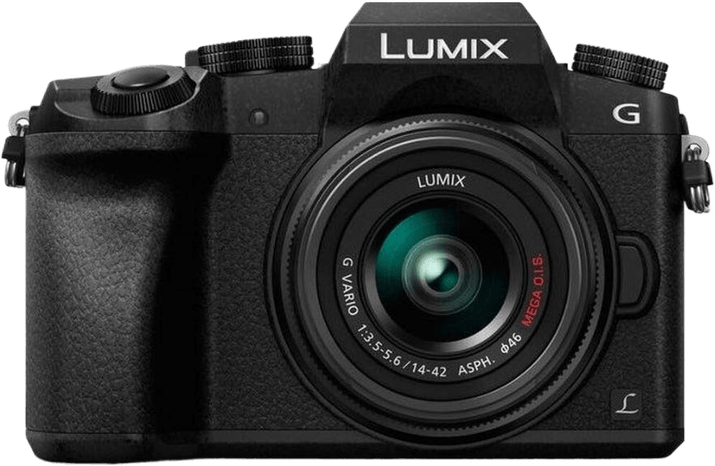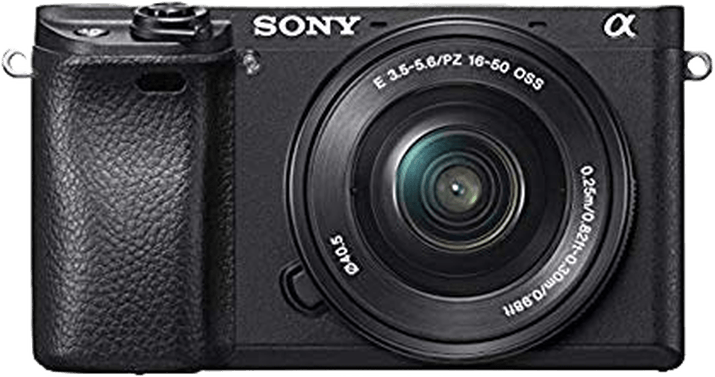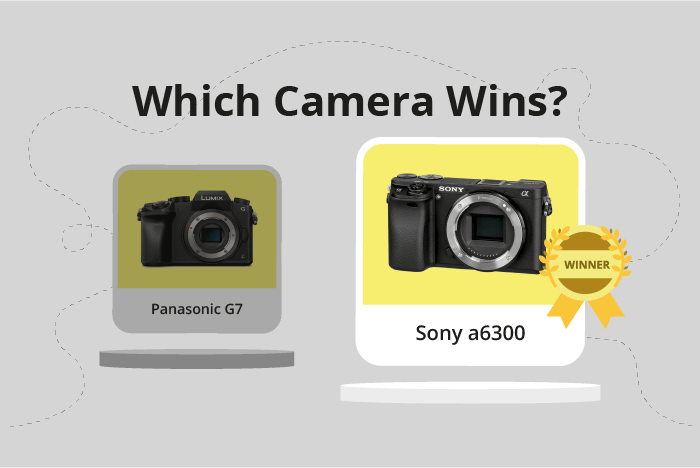Panasonic Lumix DMC-G7 vs Sony a6300 Comparison
Panasonic Lumix DMC-G7

Sony a6300

The Sony a6300 comes out as the winner with a score of 61/100, while the Panasonic Lumix DMC-G7 trails behind with a score of 52/100. Both cameras share similarities, being mirrorless and having similar weights—410g for the G7 and 404g for the a6300. The G7 was announced in 2015 and had a launch price of $799, while the a6300 was announced in 2016 with a launch price of $1000.
The Sony a6300 is superior due to its higher score, indicating better overall performance. However, the Panasonic Lumix DMC-G7 has its advantages, such as a lower price and slightly larger size, which might suit those who prefer a more substantial grip.
Considering the points mentioned, the Sony a6300 is a better camera with improved performance, but the Panasonic Lumix DMC-G7 remains a viable option for those on a budget or seeking a larger camera body.
Panasonic Lumix DMC-G7 vs Sony a6300 Video Performance
The Sony a6300 emerges as the winner in video capabilities, with a score of 91/100, outperforming the Panasonic Lumix DMC-G7, which scores 83/100. Both cameras share common specifications, such as 4K max video resolution, 3840 x 2160 max video dimensions, and built-in time-lapse functionality. However, there are significant differences that set them apart.
The Sony a6300 surpasses the Panasonic Lumix DMC-G7 with a remarkable max video frame rate of 120fps, doubling the G7’s 60fps. This higher frame rate provides smoother and more detailed slow-motion video, making the a6300 a superior choice for videographers seeking advanced video quality.
On the other hand, the Panasonic Lumix DMC-G7 still offers a solid video performance with its 60fps max video frame rate, satisfying the needs of most casual users and enthusiasts. While it is outperformed by the Sony a6300, the G7 remains a respectable choice for video capture, especially considering its lower price point.
Taking these factors into account, the Sony a6300 is the clear choice for videographers who prioritize top-notch video quality and smooth slow-motion capabilities. However, the Panasonic Lumix DMC-G7 should not be dismissed, as it still delivers satisfactory video performance for casual users and those on a tighter budget. Ultimately, the decision lies in the hands of the individual, weighing the importance of advanced video features against cost considerations.
Panasonic Lumix DMC-G7 vs Sony a6300 Features and Benefits
The Panasonic Lumix DMC-G7 wins in the feature comparison with a score of 58/100, while the Sony a6300 scores 54/100. Both cameras share some common specifications, such as a 3-inch screen size, the absence of GPS, and the presence of WiFi connectivity. Neither camera has Bluetooth capabilities.
The Lumix G7 outperforms the a6300 in some key aspects. It boasts a higher screen resolution of 2,360,000 dots, compared to the a6300’s 921,600 dots. This difference provides the G7 with a clearer and more detailed display for better image review and composition. Moreover, the G7 has a touchscreen, which allows for more intuitive and efficient control of the camera settings and focus points. This feature is absent in the a6300.
On the other hand, the a6300 does not have any significant advantages over the G7 in terms of features. Both cameras have flip screens, but the presence of a touchscreen in the G7 makes it a more versatile option. The lack of GPS and Bluetooth in both cameras does not give the a6300 any edge over the G7.
Based on this comparison, the Panasonic Lumix DMC-G7 is the better camera in terms of features. Its higher screen resolution and touchscreen capabilities give it an advantage over the Sony a6300. While the a6300 does not have any standout features to surpass the G7, it remains a competent camera with a solid feature set. However, for users seeking a more advanced and user-friendly experience, the Lumix G7 is the clear choice.
Panasonic Lumix DMC-G7 vs Sony a6300 Storage and Battery
The Panasonic Lumix DMC-G7 triumphs over the Sony a6300 in storage and battery with a score of 35 out of 100, while the Sony a6300 scores 24. Both cameras share the same specifications in terms of memory card slots and accepted memory cards. They each have one memory card slot and accept SD, SDHC, and SDXC cards.
The Lumix DMC-G7 has a slight edge due to its USB charging capability, which the Sony a6300 lacks. This feature allows for more convenient charging options for the Panasonic camera. However, the Sony a6300 does provide a longer battery life with 400 shots compared to the Lumix DMC-G7’s 350 shots. This means that the Sony camera can capture more images before needing a battery replacement or recharge.
Despite the longer battery life of the Sony a6300, the Panasonic Lumix DMC-G7’s USB charging feature and overall higher score make it a superior choice in terms of storage and battery.
Panasonic Lumix DMC-G7 vs Sony a6300 – Our Verdict
Are you still undecided about which camera is right for you? Have a look at these popular comparisons that feature the Panasonic Lumix DMC-G7 or the Sony a6300:

